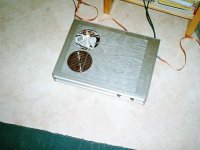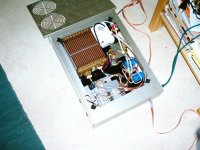Yes that could be an option, but then it would not be so technical and exciting
Perfectly good reason! To make it more logical, the radiator shouldbe in anoother location- then you can use a fan.
It's funny- others have done the same water cooling, when fans directed at their heatsinks woulds probably work as well but noisier!
The right solution IMHO is to have fan cooled amps in the adjacent room, with just speaker wires penetrating the wall.
But I'm human too: We all want to stare proudly at our amps while listening!!
Almost finished now.. Brinkster.com didn't like my files so I'm still looking for a place to put pictures in.
Power indicator LED isn't there yet and I'm putting a little fan (to run only when needed) for cooling the trafo. It's getting quite hot, 2 amps continuously and it isn't too powerful either..
Power indicator LED isn't there yet and I'm putting a little fan (to run only when needed) for cooling the trafo. It's getting quite hot, 2 amps continuously and it isn't too powerful either..
Attachments
Have you seen this project on Shinichi Kamijo's site (in Japanese)?
http://www.ne.jp/asahi/evo/amp/b753d843w/intro.htm
http://www.ne.jp/asahi/evo/amp/b753d843w/report.htm
This is a no global-NFB 30W Class A bipolar amp that is designed to be installed inside the speaker cabinet, and without any output emitter resistors (it has a trick biasing scheme to help accomplish this).
regards, jonathan carr
http://www.ne.jp/asahi/evo/amp/b753d843w/intro.htm
http://www.ne.jp/asahi/evo/amp/b753d843w/report.htm
This is a no global-NFB 30W Class A bipolar amp that is designed to be installed inside the speaker cabinet, and without any output emitter resistors (it has a trick biasing scheme to help accomplish this).
regards, jonathan carr
- Status
- Not open for further replies.

